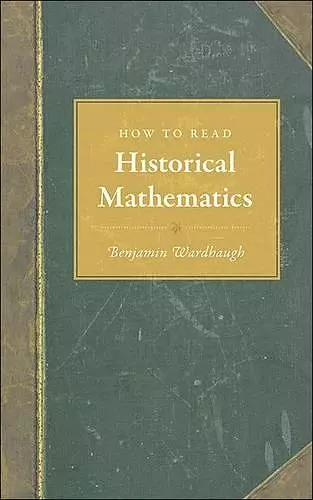How to Read Historical Mathematics
Format:Hardback
Publisher:Princeton University Press
Published:6th Apr '10
Currently unavailable, and unfortunately no date known when it will be back

How to Read Historical Mathematics is definitely a significant contribution. There is nothing similar available. It will be a very important resource in any course that makes use of original sources in mathematics and to anyone else who wants to read seriously in the history of mathematics. -- Victor J. Katz, editor of "The Mathematics of Egypt, Mesopotamia, China, India, and Islam" Wardhaugh guides mathematics students through the process of reading primary sources in the history of mathematics and understanding some of the main historiographic issues this study involves. This concise handbook is a very significant and, as far as I know, unique companion to the growing corpus of sourcebooks documenting major achievements in mathematics. It explicitly addresses the fundamental questions of why--and more importantly how--one should read primary sources in mathematics history. -- Kim Plofker, author of "Mathematics in India"
Writings by early mathematicians feature language and notations that are quite different from what we're familiar with today. Sourcebooks on the history of mathematics provide some guidance, but what has been lacking is a guide tailored to the needs of readers approaching these writings for the first time. This book intends to fill this gap.Writings by early mathematicians feature language and notations that are quite different from what we're familiar with today. Sourcebooks on the history of mathematics provide some guidance, but what has been lacking is a guide tailored to the needs of readers approaching these writings for the first time. How to Read Historical Mathematics fills this gap by introducing readers to the analytical questions historians ask when deciphering historical texts. Sampling actual writings from the history of mathematics, Benjamin Wardhaugh reveals the questions that will unlock the meaning and significance of a given text--Who wrote it, why, and for whom? What was its author's intended meaning? How did it reach its present form? Is it original or a translation? Why is it important today? Wardhaugh teaches readers to think about what the original text might have looked like, to consider where and when it was written, and to formulate questions of their own. Readers pick up new skills with each chapter, and gain the confidence and analytical sophistication needed to tackle virtually any text in the history of mathematics. * Introduces readers to the methods of textual analysis used by historians * Uses actual source material as examples * Features boxed summaries, discussion questions, and suggestions for further reading * Supplements all major sourcebooks in mathematics history * Designed for easy reference * Ideal for students and teachers
One of Choice's Outstanding Academic Titles for 2010 "Anyone interested in the history of mathematics should start here, especially those who teach history of mathematics courses. The text is refreshing, relevant, and surprisingly interesting. A great read!"--Choice "[This book] is well written, readable, and straightforward... It should be read by anyone who is using original source material to study the history of mathematics."--David Ebert, Mathematics Teacher "This is an extraordinary book for anyone interested in the history of mathematics. The author notes in the preface that reading historical mathematics can be fascinating, challenging, enriching, and endlessly rewarding. He then proceeds to illustrate how to analyze and get the most out of original source material."--Jim Tattersall, MAA Reviews "What Wardhaugh does exceptionally well is to break the ice for readers interested in the subject. He does this largely by training readers to ask insightful questions when they read a historical text."--Sol Lederman, Wild About Math "How to Read Historical Mathematics is filled with worthwhile advice to historians of mathematics and potential historians of mathematics. Wardhaugh's book should be readily available and kept with your personal reference books. It should also be in your school library."--Donald Cook, Mathematical Review "[A] splendid introduction to what to look for and to think about when reading historical source material in mathematics... This volume provides much food for thought in relatively few pages, yet in a pleasantly relaxed manner."--Leon Harkleroad, Zentralblatt MATH "How to Read Historical Mathematics is more than a useful aid to students being introduced to the field: it is a practical field guide to a whole new way of doing the history of mathematics. I warmly recommend it."--Amir Alexander, British Journal for the History of Science "Although Wardhaugh's examples will likely appeal mainly to those already interested in the history of mathematics, his commentary is broadly applicable to all of history of science and indeed to all students of history generally. There are occasional mentions of technological tools unknown to earlier generations of historians, but for the most part the discussion is generic enough that one expects How to Read Historical Mathematics to remain relevant even in a future where JSTOR and Google Books may no longer have the place they hold now."--David Lindsay Roberts, ISIS "Each item is preceded by a brief sketch of its author and context. The entertainment for the reader rests not only with the mathematical content but also in the evolution of expository style and often inventive presentation."--E. J. Barbeau, Mathematical Reviews Clippings "The book is a small jewel, the book to give to the student who is interested in pursuing history of mathematics. The author is apparently a talented historian."--UMAP Journal
- Short-listed for Choice Magazine Outstanding Reference/Academic Book Award 2010
ISBN: 9780691140148
Dimensions: unknown
Weight: 227g
136 pages